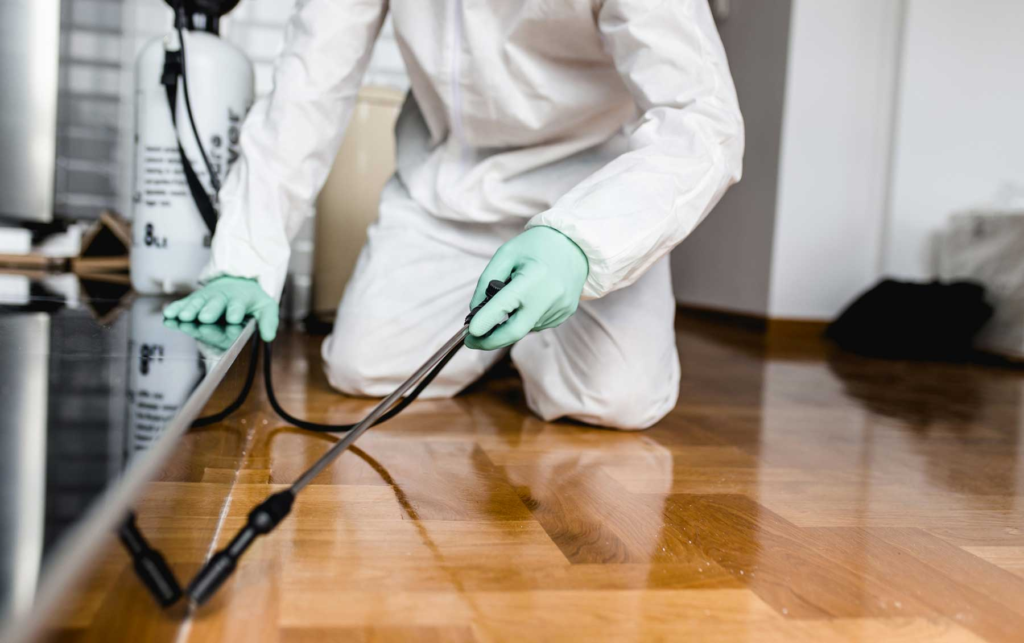Pest Control Chesterfield MO is a series of steps to safely and effectively manage pests. Preventative measures include removing food sources, hiding places and watering holes. Clutter should be removed, and leaky plumbing repaired. Natural enemies can be introduced to help reduce pest populations, such as pheromones and juvenile hormones.
Control methods should be chosen carefully to minimize harm to the environment and humans. IPM strategies include prevention, suppression and eradication.

Pests cause a multitude of problems, from damaging property to making asthma and allergies worse. They may also carry disease-causing bacteria and viruses, including food poisoning. For these reasons, it is important to take preventive steps to keep pests at bay.
Keeping pests out of facilities is a team effort, with building owners, managers, supervisors and maintenance workers all playing a role. The following preventive measures can help:
Regularly inspecting and sealing entry points is a crucial first step. Even the tiniest cracks, crevices and openings provide opportunities for pests to enter. For example, roaches can squeeze through gaps as thin as 1 cm.
Proper waste management, ensuring all trash cans are tightly sealed and regularly emptied, reduces potential food sources. In addition, keeping yard debris, weeds and overgrown vegetation away from the foundation of buildings eliminates hiding spots for pests.
Routine pest inspections are essential to detecting infestations early, which allows for timely intervention. This can be done through a combination of visual and non-visual methods. Non-visual methods include the use of sticky traps and pheromone lures, which mimic natural pheromones that attract pests. The use of pheromones is an alternative to toxic chemicals, which can be harmful to human health and the environment.
Creating sanitary perimeters on floors by arranging shelving and cabinets in an organized manner decreases the number of places for pests to hide. It is also important to have clear lines of sight around walls, so pests can be detected more easily.
Many pests are sensitive to light, so a simple lighting plan can help deter them. For example, a light on and off schedule or dimming lights on and off can change the way that a room is perceived by insects and rodents.
In addition to the above preventive measures, biological pest control methods are an option for reducing pest populations. Biological pest control uses living organisms to kill or repel pests, such as nematodes (microscopic worms). These methods can be effective but are usually only suitable for small-scale infestations and can take time to work.
Suppression
Pests are a nuisance and can cause serious health issues as well as property damage. They also spread viruses and bacteria and leave behind faeces. It is important to take the right measures to control them. The most effective way is to prevent them from entering the home. This can be done by removing any clutter that provides hiding places for them and by caulking cracks in the walls or around pipes. It is also a good idea to keep food in sealed containers. Then there is the option of using traps and baits to catch them before they can infest your kitchen.
Some of these pests are continuously present, while others come and go depending on environmental conditions. Continuous pests include weeds, diseases and insects that destroy crops. Sporadic pests include animals that feed on plants or animal-like organisms that destroy other creatures. Plants are more susceptible to disease and insect attack in times of drought or other adverse weather conditions.
Preventive methods of pest control include crop rotation, use of barriers to exclude pests and use of natural enemies. Crop rotation helps to break pests’ life cycles and prevents resistance to chemical controls. Planting disease-resistant varieties can also reduce the need for pesticides. The use of trap crops, such as zinnias, to lure and kill Japanese beetles, can also be an effective control method.
Other natural control methods include birds, reptiles, fish, mammals and amphibians that prey on some pests or parasite them. Similarly, certain pathogens, such as viruses and fungi, can suppress pest populations by attacking them or their hosts.
Classical biological control involves deliberately introducing natural enemies of pests to manage them. This can be done by breeding them in the laboratory and releasing them into an environment, or by augmentation of naturally occurring natural enemies in an area. The latter approach has the advantage of being more sustainable than broad-scale chemical applications.
Pheromones can also be used to monitor pest populations. For example, a manufactured copy of the pheromone that female insects release to attract males can confuse them and lead to lower numbers of pests. Pheromones can also be used in conjunction with traps to confuse pests and prevent them from laying eggs.
Eradication
In outdoor pest control, eradication is usually not the goal, since eliminating certain pests can have significant negative impacts on surrounding environments and human populations. However, in some cases (especially with introduced pests), eradication is possible. Such efforts may be supported by the government, especially in urban and agricultural settings.
Physical or mechanical controls can be used to limit pests. These methods include traps, screens, fences, radiation and other techniques that modify an environment to reduce pest emergence or growth.
Eliminating pests by killing them or their eggs is another way to reduce their numbers. This is often accomplished by insecticides, although less toxic baits or plant extracts can also be used.
Pesticides can be delivered by spray, gel or dust. Some products are designed to be non-repellent, which allows them to work more effectively in difficult to reach places where pests hide. Some of these products are odourless and safe to use for children and pets. However, it is important to always read the label before using any product to ensure it is correctly applied and is not causing harm or discomfort to humans or pets.
Good sanitation practices can help prevent and suppress some pests, particularly in urban or industrial settings. This includes proper garbage disposal, cleaning up spills and crumbs, and ensuring that food is not stored in places where pests can access it. In agricultural settings, sanitation can include improving manure management, removing crop debris and increasing the frequency of garbage pickup.
It is advisable to call a professional when dealing with a pest problem, as they have the knowledge and equipment to get rid of the unwanted invaders in the most effective manner. This is because pests can cause severe damage to properties and agriculture, not to mention health issues for the people living in them.
Depending on the nature of the pest, some can be considered a nuisance, like silverfish and earwigs; others present a health risk, such as rodents and cockroaches; and others pose a threat to personal items, like pine seed bugs and clothes moths. IPM recommends that before you roll up your sleeves and try to eradicate pests, consider if they really are a problem for you.
Monitoring
Pest control relies on monitoring to detect and correct pest problems. Basically, monitoring involves checking or “scouting” an area to see what pests are present, how many of them there are and what damage they’re doing. This information can help determine whether a pest infestation has reached a threshold at which some type of control action becomes necessary. For example, a few wasps hovering around a building might not warrant pest control treatment, but if you find that they’re accumulating in numbers each day and attacking plants or damaging equipment, then they require action.
Some pests are continuous (such as cockroaches, flies and mosquitoes) and require frequent monitoring; others are sporadic (such as rodents, birds and beetles). Many pests are also cyclical and need only occasional control.
Monitoring methods depend on the types of pests, but typically include visual inspection, trapping and reporting to management. Some traps are passive and simply catch a pest in the act of coming into or leaving an area, while others have a physical shape, attractant or pheromone that targets the behavior of certain pest species. For example, a pheromone that mimics the female insect’s odor can be used to lure male insects away from the target area and reduce populations.
In addition, certain monitoring techniques can help identify underlying conditions that contribute to pest infestations. For instance, if your pest control technician finds that the number of ants in a trap is increasing, it could mean that a change to the plant’s environment would be beneficial, such as reducing moisture levels.
Another useful piece of data that can be gleaned from monitoring is the history of previous treatments and their effectiveness. A record of prior treatments can help you avoid unnecessary treatments, but it’s important to remember that even the best preventive measures aren’t foolproof. For example, if you install rodent bait stations in areas that rat and mouse activity is most likely to occur—generally ceiling voids and subfloors—it’s possible the mice or rats will migrate elsewhere, such as into employee break rooms.
When an infestation is detected, it’s important to react quickly. Thresholds can be set to trigger control tactics as soon as the pest population reaches unacceptable levels, but it’s always preferable to mitigate issues at their inception before they become severe. For example, when a health care facility found German cockroaches in their monitors, they addressed the problem immediately by cleaning and using targeted baiting to ensure that any remaining cockroaches were confined to the employee break room.



